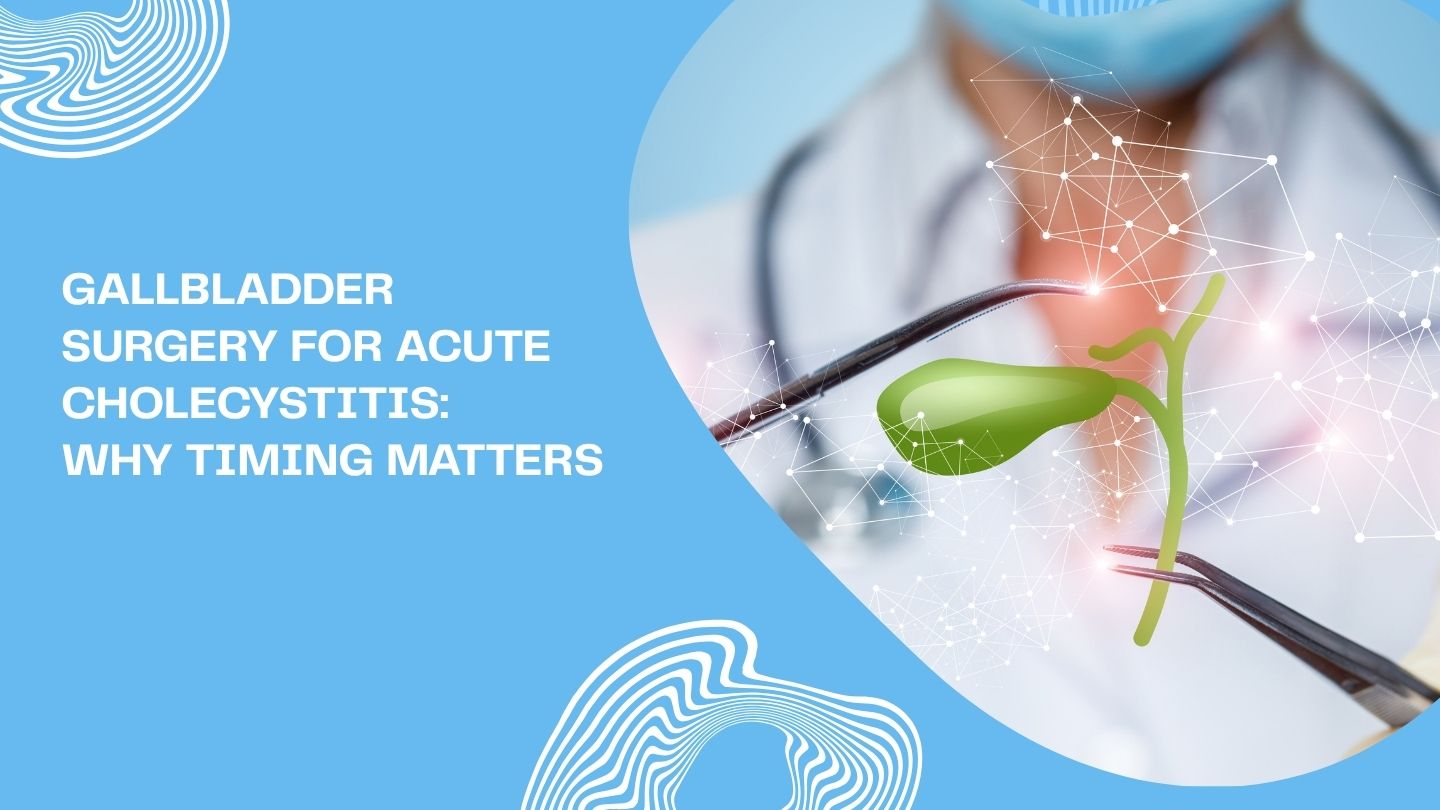
Gallbladder Surgery for Acute Cholecystitis: Why Timing Matters
Acute cholecystitis, or inflammation of the gallbladder, is a serious condition that often develops when gallstones block bile flow. The resulting pain, fever, and infection can escalate quickly if not treated promptly. Timely medical intervention is crucial to prevent complications and ensure a smoother recovery. Surgical removal of the gallbladder remains the most effective treatment for long-term relief. In this blog, we’ll discuss how early surgical intervention impacts recovery outcomes and why proper timing is critical for patient safety.
Key Takeaways
- Timely laparoscopic cholecystectomy within 72 hours of acute cholecystitis onset significantly enhances patient outcomes, reducing hospital stays and costs.
- Early surgery lowers the risk of complications, including conversion to open surgery and postoperative issues, which improves overall patient safety.
- Identifying suitable candidates for early surgery is crucial; factors like inflammation severity and overall health influence surgical urgency and effectiveness.
Importance of Timing in Gallbladder Surgery
Timing is paramount in gallbladder surgery, especially for acute cholecystitis. Research shows that surgery within two days of acute cholecystitis onset significantly improves patient outcomes. The Tokyo Guidelines recommend early laparoscopic cholecystectomy soon after acute cholecystitis admission. This approach is not just a matter of following protocol; it has tangible benefits for patients.
Early laparoscopic cholecystectomy saves time, reduces hospital costs, and enables faster patient recovery. Studies indicate that early surgery results in a significantly shorter hospital stay compared to delayed surgery. This reduced hospital stay not only eases the burden on healthcare facilities but also minimizes the disruption to patients’ lives.
The optimal timing for laparoscopic cholecystectomy is typically within 72 hours of symptom onset, with the following considerations:
- Intervention within 24 hours yields even better results.
- Early laparoscopic cholecystectomy during acute admission significantly improves patient outcomes.
- This approach is established as the gold standard for treating acute cholecystitis.
- Timely surgery helps manage the condition more effectively and reduces the likelihood of complications.
The importance of timing extends beyond just the clinical outcomes. Timely laparoscopic cholecystectomy plays a critical role in improving overall patient experiences, particularly for individuals already experiencing early signs of gallbladder disease that signal the need for urgent medical evaluation and treatment. Patients undergoing early surgery often experience better recovery and quicker returns to daily routines. In the fast-paced world we live in, the ability to bounce back quickly from a medical procedure is a significant advantage.
Next, we will explore the specific benefits of early laparoscopic cholecystectomy and the risks of delayed surgery. The following sections will provide a comprehensive look at why acting swiftly is not just recommended but essential in the management of acute cholecystitis.
Early Laparoscopic Cholecystectomy Benefits

The advantages of early laparoscopic cholecystectomy are manifold, making it the preferred option for treating acute cholecystitis:
- Significant reduction in hospital stay length for those undergoing surgery within 24 hours
- Alleviation of strain on healthcare resources
- Allows patients to return to their everyday lives more swiftly
Laparoscopic cholecystectomy within 72 hours of admission can lower hospital costs. Early laparoscopic cholecystectomy reduces hospital time, minimizing overall healthcare expenses for treating acute cholecystitis. This economic benefit is particularly important in a healthcare system where cost-efficiency is a critical concern.
Early surgery patients exhibit a lower complication rate compared to those with delayed surgery. This reduction in complications significantly improves patient safety and enhances the procedure’s success rate. Studies show that early laparoscopic cholecystectomy does not increase complication risks compared to later surgery, highlighting the benefits of early versus delayed cholecystectomy intervention. This reinforces the notion that early intervention is both safe and effective.
Timing significantly impacts recovery, with early surgery linked to quicker returns to normal activities. Patients undergoing early laparoscopic cholecystectomy often face fewer postoperative issues and resume daily routines sooner. This faster recovery is a considerable advantage for patients who wish to minimize the disruption to their personal and professional lives.
Most evidence supports a 72-hour post-admission timeframe for optimal time outcomes in laparoscopic cholecystectomy for acute cholecystitis. This window allows for effective management of the condition while minimizing the risks and complications associated with delayed surgery.
Next, we will explore the potential risks and complications of delayed laparoscopic cholecystectomy.
Delayed Laparoscopic Cholecystectomy Risks
Delaying laparoscopic cholecystectomy beyond the recommended 24-hour window can lead to increased complications and risks. A significant risk of delayed surgery is the increased likelihood of conversion to open surgery. This conversion prolongs recovery time and increases postoperative complications, particularly in cases of delayed cholecystectomy and delayed interval laparoscopic cholecystectomy.
Postoperative complications in laparoscopic cholecystectomy are primarily caused by bleeding and infection, which can contribute to postoperative morbidity. Delayed surgery can worsen acute cholecystitis severity, leading to higher surgical complications and operative complications. This correlation underscores the importance of early intervention.
Delayed laparoscopic cholecystectomy also risks bile duct injuries and bile leakage. These complications can significantly impact the patient’s recovery and overall health, often requiring additional medical interventions to manage. The increased risk of bile duct injuries in delayed surgeries highlights the need for timely surgical management of the cystic duct.
Delayed laparoscopic cholecystectomy can also result in prolonged postoperative hospital stays. This extended stay increases the burden on healthcare facilities and disrupts patients’ lives, delaying their return to normal activities. These cumulative risks make a compelling case for opting for early laparoscopic cholecystectomy whenever possible. Additionally, the delayed LC can exacerbate these issues.
Next, we will focus on identifying the best candidates for early surgery. Most patients may benefit from understanding the criteria for early intervention, which can help healthcare providers make informed decisions and optimize patient outcomes through definitive treatment in a retrospective cohort study.
Identifying Candidates for Early Surgery

Identifying the right candidates for early laparoscopic cholecystectomy is crucial for optimal outcomes. Patients with severe acute calculous cholecystitis typically require immediate surgery, as delayed acute cholecystitis can lead to worsened conditions. Inflammation severity plays a pivotal role in determining surgical urgency.
In cases of moderate acute cholecystitis, delaying surgery can increase both the conversion to open surgery and complication rates. Assessing gallbladder inflammation, including acute inflammation, is essential in identifying candidates for early laparoscopic cholecystectomy. Healthcare providers use diagnostic criteria and imaging to evaluate the extent of inflammation and decide on surgery timing.
Candidates for early laparoscopic cholecystectomy ideally have a normal BMI and no history of severe abdominal surgery for better outcomes. These characteristics are crucial in determining suitability for early intervention. Patients with a lower risk profile are more likely to benefit from early surgery, experiencing fewer complications and faster recovery times.
The selection process for early surgery also involves evaluating the patient’s overall health and comorbidities. Patients with fewer underlying conditions are generally better candidates for early laparoscopic cholecystectomy, especially when supported by the expertise of a surgeon for gallbladder removal who can assess risks and ensure safe, timely intervention. Careful evaluation helps optimize surgical outcomes and ensure patient safety.
Next, we will explore management strategies for high-risk patients unsuitable for early surgery, including conservative treatment. Understanding these alternatives is essential for providing comprehensive care to all patients with acute cholecystitis.
Managing High-Risk Patients
For high-risk patients who cannot undergo immediate surgical treatment for acute cholecystitis, alternative management strategies are essential. One common alternative is percutaneous cholecystostomy, which relieves symptoms and stabilizes the patient before planned laparoscopic cholecystectomy. This approach stabilizes patients before they can undergo surgery.
Factors preventing patients from having early laparoscopic cholecystectomy include severe inflammation or secondary health conditions. Patients with comorbidities like heart disease or diabetes require careful evaluation to determine suitability for early surgery. In such cases, percutaneous cholecystostomy serves as a temporary solution until the patient is stable enough for surgery.
Conditions like jaundice or cholangitis are generally exclusion criteria for early surgery. These conditions increase surgical risks, necessitating patient stabilization before intervention. Surgeons also consider age, with many studies focusing on patients under 70 for early laparoscopic procedures.
Despite early surgery benefits, surgeons often hesitate to recommend it for severe cholecystitis due to potential complications. Emerging approaches like subtotal cholecystectomy are considered to avoid complications in high-risk patients. These strategies provide safe and effective care for patients unable to undergo cholecystectomy. For patients unable to undergo immediate surgery, conservative management can provide stability until they’re ready for intervention, supporting better recovery and emphasizing what to expect during gallbladder removal surgery as part of preparing for future treatment.
Robotic-Assisted Cholecystectomy
Robotic-assisted cholecystectomy is an emerging technology gaining traction in managing acute cholecystitis. From 2010 to 2019, the use of robotic-assisted cholecystectomy in the US increased over 30 times. This rise in popularity is due to several advantages robotic surgery offers over traditional methods.
A key benefit of robotic cholecystectomy is the lower risk of conversion to open surgery compared to traditional laparoscopic methods. This lower conversion rate is particularly beneficial in managing acute cholecystitis, where the risk of complications is higher. The precision and control of robotic systems enhance surgical outcomes and reduce postoperative complications.
Despite its benefits, robotic cholecystectomy’s overall effectiveness in emergencies is still under evaluation. While promising, more research is needed to establish its role as standard practice in managing acute cholecystitis. However, the initial results are encouraging, and many surgeons are optimistic about its potential.
Robotic-assisted cholecystectomy is gaining traction as a potential standard for managing acute cholecystitis. Its growing popularity is a testament to the advancements in surgical technology and the ongoing efforts to improve patient outcomes. As this technology evolves, it may become more widely adopted for treating acute cholecystitis.
Next, we will explore the role of surgeon expertise and decision-making in managing acute cholecystitis. Understanding how surgeons experience influences outcomes is crucial for optimizing patient care.
Surgeon Expertise and Decision-Making
Surgeon expertise and decision-making are pivotal in managing acute cholecystitis. Surgeon judgment varies significantly, influencing treatment decisions due to differing perceptions of risks and benefits. These variations can impact the timing and type of surgery recommended, highlighting the importance of surgeon experience for optimal outcomes.
Surgeons often face complex decisions on surgery timing for acute cholecystitis, relying heavily on individual judgment due to insufficient high-level evidence. This reliance on personal judgment underscores the need for an experienced gastrointest surgeon who can navigate the condition’s complexities and make informed decisions.
Variations in patient status, disease process, organ anatomy, and hospital resources influence a surgeon’s judgment in managing acute cholecystitis. These factors contribute to decision-making complexity and the need for a personalized approach to each patient’s care. Surgeons must consider these variables to tailor their treatment plans effectively.
Experience with robotic-assisted cholecystectomy significantly reduces bile duct injury incidence. Key points include:
- Surgeons may need to complete 300-450 robotic procedures to attain equivalent safety profiles for bile duct injuries as laparoscopic cholecystectomy.
- This level of experience is crucial for ensuring surgical safety.
- Achieving the best possible outcomes for patients depends on this experience.
The choice between standard laparoscopic cholecystectomy and percutaneous cholecystostomy is influenced by perceived risks and benefits, which vary among surgeons. Understanding these significant differences existed in surgeon judgment can aid in making informed decisions regarding minimally invasive surgery and improving patient care. However, there is a significant difference in how these procedures are perceived by different practitioners.
Next, we will explore recent trends in managing acute cholecystitis, providing insights into evolving practices and advancements.
Recent Trends in Acute Cholecystitis Management
Recent trends in the management of acute cholecystitis reflect significant advancements in surgical techniques and decision-making processes:
- Laparoscopic cholecystectomy is now performed in up to 90% of gallbladder removal cases.
- It has become the standard treatment for acute cholecystitis.
- This widespread adoption underscores the effectiveness and reliability of laparoscopic surgery in managing this condition.
Endoscopic techniques for gallbladder drainage are being explored as alternatives, although they are not yet standard practice in the US. These techniques offer potential benefits for patients who may not be ideal candidates for traditional laparoscopic cholecystectomy, percutaneous transhepatic gallbladder drainage, and endoscopic retrograde cholangiopancreatography. As research and clinical trials continue, these endoscopic methods may become more widely accepted and integrated into standard practice, as previously reported.
Surgeons are increasingly encouraged to integrate data-driven decision support tools to help align their recommendations with best practice guidelines. These tools can provide valuable insights and support informed decision-making, ensuring that patients receive the most appropriate and effective care. The use of such tools represents a move towards more personalized and evidence-based approaches in the management of acute cholecystitis.
The focus on improving patient outcomes has led to the exploration of various surgical and non-surgical interventions. The goal is to provide the best possible care while minimizing risks and complications. This ongoing evolution in management practices highlights the commitment to enhancing the quality of care for patients with acute cholecystitis.
The Importance of Acting Quickly for Better Outcomes
Timely intervention for acute cholecystitis is essential to prevent severe complications and promote faster recovery. Early gallbladder removal not only reduces the risk of complications but also promotes faster healing and improved post-operative wellness, contributing to the positive long-term effects of gallbladder removal seen in patients who receive timely surgical care. Delayed treatment, on the other hand, can increase inflammation and make surgery more complex, underscoring the importance of early medical evaluation and surgical planning.
At Wellstar Comprehensive Bariatric Services, we provide expert gallbladder surgery in Cobb County, Marietta, Smyrna, Austell, LaGrange, and West GA, ensuring patients receive prompt, precise, and compassionate care. Our team uses advanced laparoscopic techniques to deliver safe, effective results and promote quicker recovery. Trust us to provide the surgical expertise and ongoing support you need to restore your health and well-being.
Frequently Asked Questions
What are the benefits of early laparoscopic cholecystectomy for acute cholecystitis?
Early laparoscopic cholecystectomy significantly shortens hospital stays, decreases complication rates, and facilitates a faster return to normal activities, making it a beneficial approach for acute cholecystitis.
How are candidates for early laparoscopic cholecystectomy identified?
Candidates for early laparoscopic cholecystectomy are typically identified by evaluating the severity of inflammation, maintaining a normal body mass index, having no history of severe abdominal surgery, and assessing overall health.
What alternatives are available for high-risk patients who cannot undergo early surgery?
For high-risk patients unable to undergo early surgery, percutaneous cholecystostomy serves as an effective alternative, offering symptom relief and stabilization prior to any future surgical intervention.
What is the role of robotic-assisted cholecystectomy in managing acute cholecystitis?
Robotic-assisted cholecystectomy plays a significant role in managing acute cholecystitis by providing lower conversion rates to open surgery and improved surgical precision, although its use in emergency cases is still being assessed.
